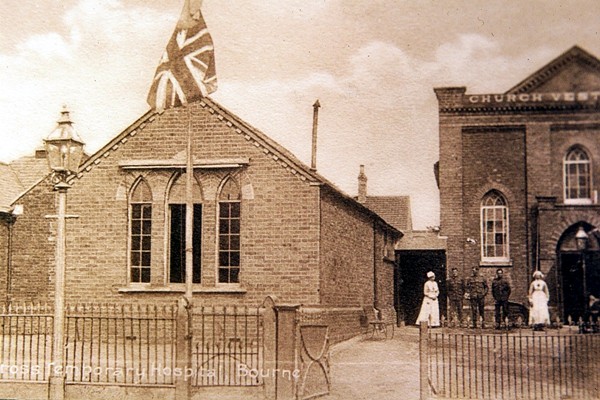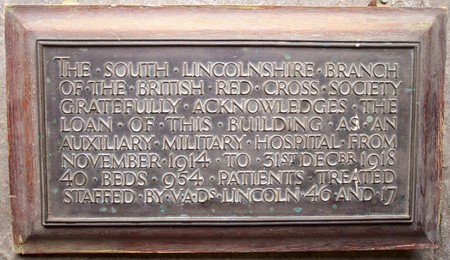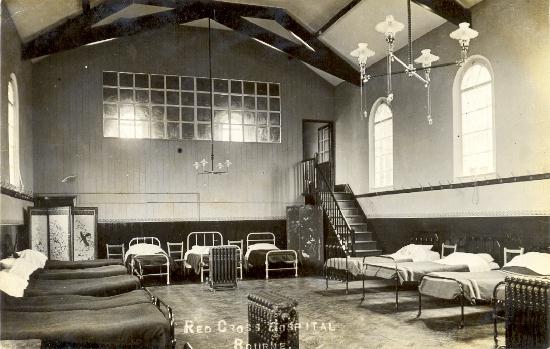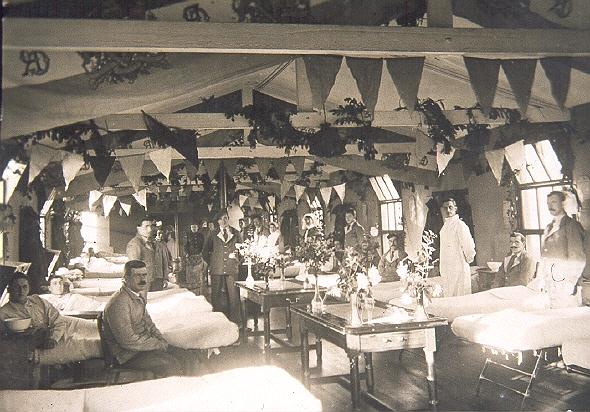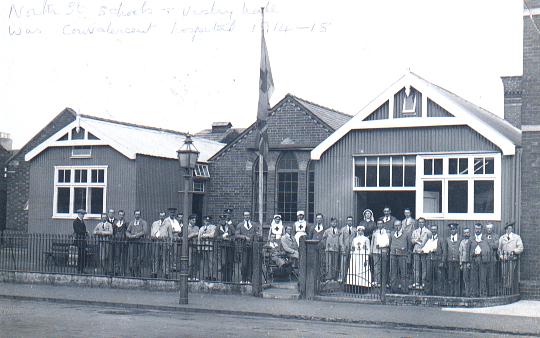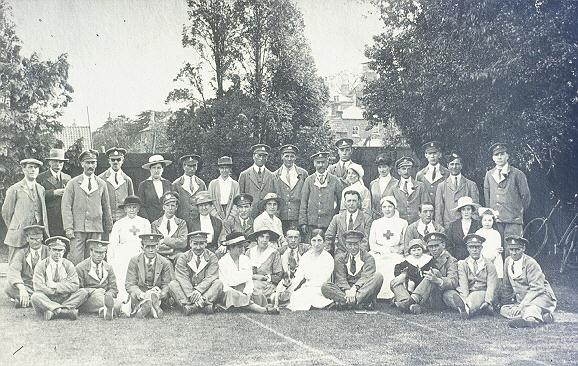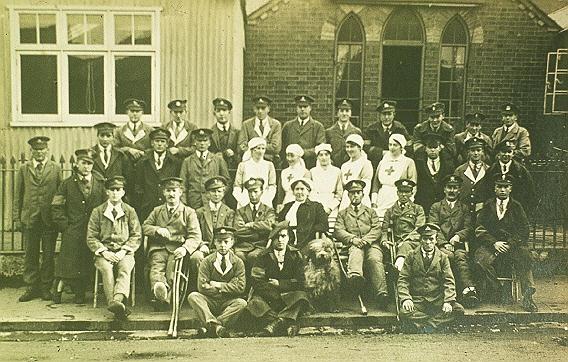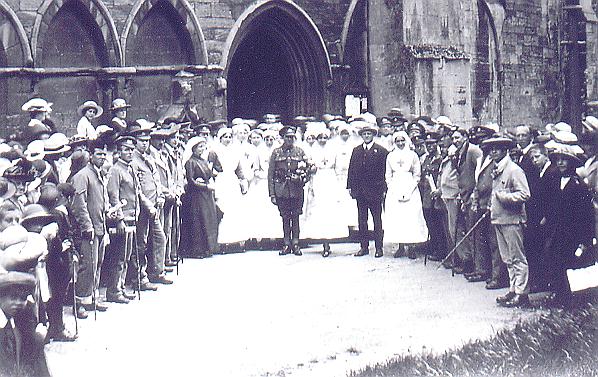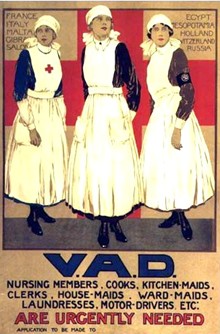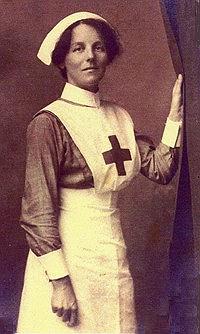|
Bourne Military Hospital
ESTABLISHED IN THE VESTRY HALL DURING THE GREAT WAR OF 1914-18
The Vestry Hall became the headquarters of the South Lincolnshire branch of the Red Cross which was formed at the outbreak of the Great War in 1914 and within a few months, it was turned into a temporary hospital for wounded soldiers returning from the front to convalesce, with additional accommodation at the National School next door.
The facility became officially known as Bourne Military Hospital and hundreds of soldiers who had been injured or gassed in France and Belgium were sent here to recuperate.
On Saturday 31st October 1914, the War Office notified Major Cecil Bell, a local solicitor with extensive military experience as the former commander of H Company, the 2nd Volunteer Battalion, the Lincolnshire Regiment, that the first detachment of wounded soldiers were being sent to Bourne within the next few days and asking the local branch of the Red Cross to make all the necessary arrangements for their reception and comfort. This immediately sparked a flurry of activity in the town and male members of the branch were summoned at once for an ambulance practice which took place in the goods shed at the railway station. A meeting was held that evening attended by all doctors in the town, the matron of the Butterfield Hospital, Miss Marion Pile, and on Sunday afternoon, members of the Red Cross committee and all available members met with Mr Arthur Wall, chairman of Bourne Urban District Council, presiding.
It was decided that the old Drill Hall in North Street, originally built as a Calvinist chapel in 1868 and then used as the church Vestry Hall, be used for the military hospital with additional accommodation in the National School next door which had an inside communicating door. Technical instruction classes organised by Kesteven Educational Authority were usually held at the school during the week but these were transferred to the Council School in Abbey Road while other venues were also found for the various meetings which were then held in the Vestry Hall, including the regular Sunday School.
A long list of requisites needed to equip the hospital was read out at the meeting and sufficient promises were made from those at the meeting to provide them the following day when horses and wagons to collect them were loaned by Messrs C C MacLeod, T B Measures, E A Beaver and T W Mays and Sons Ltd, the local firm of fellmongers. By noon on the Monday, all of the necessary items had been delivered to the Vestry Hall where beds were erected around the room. The school was equipped for cooking the food and general scullery purposes while one of the classrooms was converted into a sitting room for the soldiers. The lady members of the Red Cross, under the supervision of Miss Pile, made up the beds, 20 in all, although this number was to increase in the coming months, and in the evening, the male members polished the wood block floor and by Tuesday morning, everything was ready for the reception of the wounded.
No definite information as to numbers or arrival date had been received although preparations were made in anticipation of receiving 20 men on the Wednesday and prior to their arrival, the new temporary military hospital that had been prepared within a matter of days, was opened to the public for inspection and several hundred people turned up to take a look.
In the event, the hospital did not accept its first patients for another two weeks. Seventeen soldiers arrived in Bourne by train from Lincoln General Hospital on Tuesday 15th December 1914, and were met by a party from the Red Cross Voluntary Aid Detachment or VAD, whose members had been recruited from the community to work as nurses, orderlies, cooks and drivers. Two of the town's family doctors, John Galletly and John Gilpin, were also in attendance and Dr Gilpin was eventually appointed commandant of the hospital. The men were all convalescent and only one required assistance in walking because of a leg injury, and they were ferried to hospital in cars provided by the Earl of Ancaster, Messrs G R Holbourn, W Hosken, H P Mays, Dr Galletly, Mrs Fenwick and others. On arrival, the soldiers were allocated their various beds by the two doctors.
So began the regular arrivals of wounded soldiers from the front that continued for the rest of the war. A report from September 1915, during a week in which there were 16 fresh admissions, said that the patients came from a variety of regiments fighting in France, some who lived locally, and most of them were suffering from gunshot wounds. Once they were able to walk, the town offered them the use of its facilities. The Bourne Institute in West Street (now the Pyramid Club) made them honorary members during their stay, allowing them to borrow books and play billiards without charge, while the Bourne Angling Society granted free fishing permits to all members of His Majesty's Forces and all wounded soldiers and the Bourne Tennis Club allowed them free use of their courts which were then situated in Burghley Street.
Extensions were carried out to the hospital in 1917 when a temporary structure was built in front of the Vestry Hall and the entrance diverted through the National School, so allowing space for a further 15 patients. The work was carried out by a local builder, Mr John Henry Roberts, of North Street, and completed in April of that year.
By the time the war ended in November 1918, the hospital had forty beds and had cared for almost 950 servicemen during a four year period and the work of the staff was subsequently acknowledged by the British Red Cross Society and the War Office. A plaque on the wall inside the hall once remembered this period but has since been removed and is now preserved in the museum at the Red Hall administered by Bourne United Charities.
The closure became official on Wednesday 1st January 1919 when the remaining patients were sent back to Lincoln General Hospital and on New Year's Eve, a dance was held for those inmates who were able to take part and for the nurses and orderlies. "The arrangements were carried out under the direction of the hospital commandant, Dr Gilpin, who kindly undertook the responsibility of the whole proceedings which included the provision of refreshments", reported the Stamford Mercury. "A most enjoyable time was spent, the proceedings terminating soon after midnight. The patients left on Wednesday morning by the 9.20 am train, and were accompanied to the station by several of the nurses, the permanent orderly, Private J Stanford, and the friends of several of the men."
The task left to the volunteers who had been running the hospital was to return the building to its previous role as the Church Vestry Hall and The Stamford Mercury reported on Friday 17th January 1919:
The members of the committee and the quartermaster (Miss Gibson) have been busily engaged since the patients left in clearing up various matters in connection with the working of the hospital. When it was opened, practically the whole of the articles that were in use had been lent by various friends. Part of the work since the closing of the hospital has been the return of those articles that had survived the four years' wear and tear. This work had been largely carried out under the supervision of Miss Gibson, who had always evinced a deep interest in the work of the hospital, in the early stages as one of the nurses, and latterly as the quartermaster. In this capacity the work was considerably increased since she undertook the duties, the number of patients having been much greater during the last year or so. Her work has been appreciated by all, and none more so than the patients. In this respect, the patients initiated a tangible form of their expression of appreciation before leaving the hospital. Having received the co-operation of the nurses, a joint presentation was made to Miss Gibson by one of the patients consisting of a silver chain bag and vanity case. Miss Gibson was quite taken by surprise and expressed her thanks for the kind consideration shown.
In connection with the closing of the hospital, a children's party was held on the 18th inst. The arrangements were carried out by several of the ladies, who had acted as nurses, and other friends. The proceeds are to be given to a naval charity. A large number of children were present and were entertained by those who were responsible for the arrangements. Various parlour games were provided and dancing was a prominent feature of the proceedings. Tea was provided for the children, the arrangements for this being under the supervision of Mr Nash, of the Angel Hotel. The children were dispersed at eight o'clock but the proceedings were continued among the adults until midnight. The programme was wholly dancing, Mr E Pearce acting as MC. Miss Sampson presided at the piano for the greater part of the evening. There was a crowded attendance in the evening and a most enjoyable time was spent. Refreshments were provided for which Mr Nash and Miss Lunn were chiefly responsible.
The Church Vestry Hall was eventually re-opened in February 1919 with a celebratory concert before a crowded and enthusiastic audience and the Vicar, the Rev Harry Cotton Smith, thanked the people of Bourne for furnishing the place as a hospital.
Those who had helped during its four years in existence were officially thanked when the peace celebrations were held on Saturday 19th July 1919. During a ceremony at the Abbey Lawn, former Red Cross nurses received a gold bar brooch with a Red Cross on a white lozenge inside a circle with the inscription "Bourne V A D Hospital, 1914-18." The following were the recipients: Miss Gibson, Mrs Cabourn, Miss Cartwright (Grimsthorpe), Mrs R A Collins, Miss Cooper (Dyke), Mrs J Galletly, Miss Hinson, Miss Mays, Mrs D S Paton, Mrs E Pearce, Miss Pool, Mrs Redshaw (Dyke), Miss Scotney, Miss Shilcock and Miss Story. The following were also recipients of similar brooches in recognition of assiduous work: Miss Lunn, Miss Andrew, Miss A Bell (Thurlby), and Mrs E Holland. All, excepting where otherwise stated, resided in Bourne. In the unavoidable absence of the Countess of Ancaster, the presentations were made by Dr W J Gilpin, the hospital commandant, who spoke of the ungrudging spirit with which womankind had taken their part in the war. He himself had been awarded the MBE in June 1918 for conducting the hospital in such an efficient manner.
These photographs are a surviving record of the conditions that existed
The
interior of the Vestry Hall is pictured above, ready perhaps for the daily
More
pictures outside the hospital of nurses in their distinctive white
Wounded
soldiers with members of the Bourne Tennis Club at their courts
There
were romances between the nurses and their patients and at least one
See also
An album of photographs of hospital patients
Dr John Gilpin Ida Wiggin Bourne's angels of mercy
Go to: Main Index Villages Index
|
|||||||||
